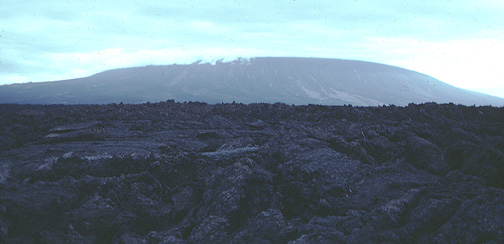|
Description of the Galapagos Islands Isla Fernandina  | | A picture of the flat topped Fernandina. Picture source: http://www.geo.cornell.edu/geology/GalapagosWWW/Fernandina.html |
Fernandina, also known as Narborough Island, consists of a single large volcano, which rises to an elevation of 4500 feet (1400 m). It is probably the youngest volcano in the archipelago and is certainly the most active, erupting every few years, most recently in 1988, 1991, and 1995 (which produced a large lava flow from a vent on the west flank. Like the volcanoes of Isabela, it has a distinctive "inverted soup-bowl' shape with steep upper slopes and a large central caldera. Fernandina's caldera is over 1100 feet deep. At times, a small lake has formed in the north part of the caldera. The lake was last present in 1988; it disappeared after a section of the caldera wall collapsed.
Calderas form as a result of collapse following magma withdrawal from the underlying magma chamber. The calderas of the Galapagos probably form from multiple collapses. The most recent collapse (and the only historically documented collapse of a caldera in the Galapagos) on Fernandina occurred in 1968. The collapse followed a brief eruption at an elevation of about 700 m on the eastern flank on May 21. At 10 AM on June 11, an earthquake occurred and was followed by the rise of a large white cloud that was visible from Santa Cruz. At 4 PM, a dark ash cloud was spotted by a fishing boat in Urvina Bay, 35 km east of the caldera. At 5 PM a large boom was heard and was followed by smaller exposions for several hours and a number of earthquakes that lasted over a week, the largest of which was a magnitude 5 occurring on June 15. A party from Darwin Station reached the summit on June 19, but could see little because of the dust generated by constant avalanches. When the dust finally did clear a week later, it was apparent that the southeastern part of the caldera floor had dropped as much as 300 m, with only minor subsidence on the opposite side. Calderas may also grow when parts of the wall break off, collapsing into the caldera. A southeast section of Fernandina's caldera wall collapsed in this way following the 1988 eruption, widening the caldera by 300 m and producing a 250 m thick pile of debris in the bottom of the caldera.
Many of the lavas on Fernandina originate from crcumferential fissues on the wide, flat bench surrounding the caldera or vents near the base of the ediface. Others orginate from vents aligned along radial fissures on the lower flanks. Interestingly, there are few radial fissures in the summit area and few circumferential ones on the lower flanks. Most of the lavas are aa, as opposed to pahoehoe. Pahoehoe lavas on Fernandina are largely resticted to vents on the coast plain. Aa is extremely difficult to walk on, making the climb to the summit a difficult one. Whether a lava flow forms pahoehoe or aa depends on flow rate. The predominance of aa probably reflects a combination of steep slopes and high magma discharge rates. You can find out more about Fernandina at the Fernandina Web Site hosted by the NASA EOS IDS Volcanology Team at Michigan Technological University.
Fernandina has not suffered as much from the presence of man (particularly, the animals he has left) as other islands, so the indiginous wildlife is still abundant. Among the animals to be seen there are marine and land iguanas, tortoises, hawks, sea lions and a great variety of sea birds, such as flightless cormorants.
|







